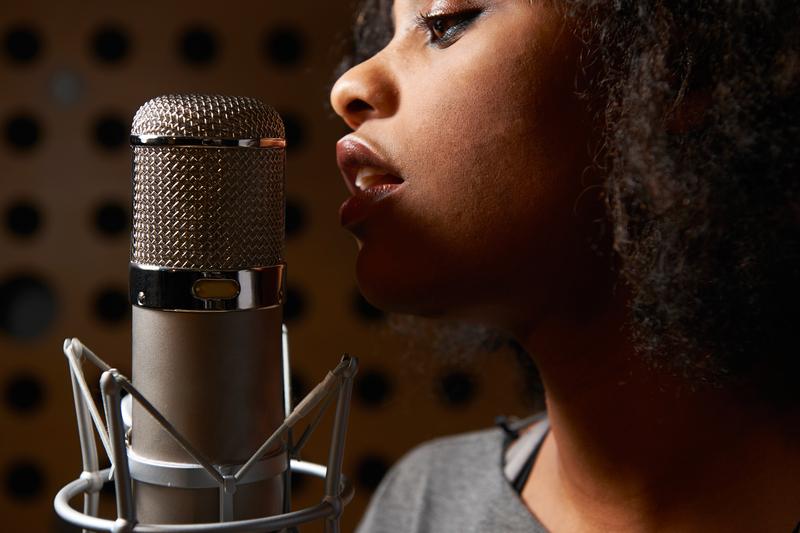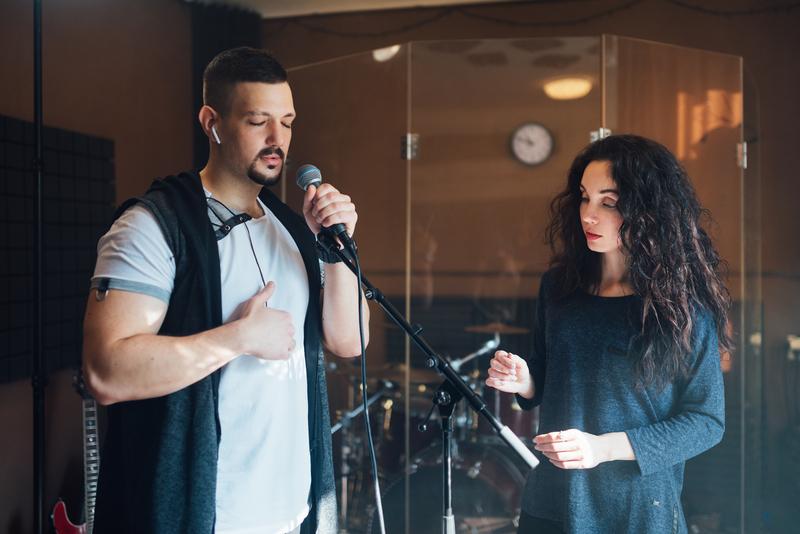Top 10 Singing Techniques To Improve Your Vocals

For centuries, people have sung across the world to entertain and enlighten an audience. Whether you’re a professional singer or you simply enjoy singing in the shower like most people—there are so many singing techniques to help you improve and become a bigger an better vocalist.
However, mastering the art of singing can take a tonne of work, especially if you’re not massively experienced at the art.
Still, there are several techniques you can use to take your singing level to the next level, from correct breathing techniques to vocal workouts.
In this article, we’ll look at the best ways to improve and look after your voice.

Top Ten Ways To Improve Your Singing
1. Practice Continually
One of the best ways to improve your singing skills is by practising continually.
Just like any skill in the world—from football to drawing—you’ll need to practise consistently to improve and develop your talents. And singing is simply no different.
First, it’s key to set aside time daily to practise. Obviously, the more, the better; if you can only do ten minutes daily, that’s also fine.
As long as you keep practising, you’ll grow your skills. You might want to start with short practice sessions and work up. That way, your voice will become used to the stringent sessions, making it less prone to damage.
Second, it’s equally as important to practise smart; the best musicians will have the right materials required to practise efficiently, including courses and books.
You should focus on developing good habits and techniques. These can include breathing, vocal range, overall tone quality, and pitch accuracy to boost your types of singing and voice.
Third, you must make your practice sessions fun and enjoyable; there’s nothing worse than boring practice. In turn, you’re more likely to quit if you reach a plateau.
You can use technology to make the sessions fun, such as using a tuning app and a metronome to adjust your timing and pitch accuracy.
Fourth, you might want to hire a vocal coach for your practice sessions. The average person can’t tell you where you need to improve and where you’re going wrong.
In contrast, a vocal coach knows precisely where you’re going wrong, and they can offer techniques and exercises to help you improve during your practice.
2. Use Good Breathing Techniques

If you want to boost your vocal style, it’s key to adopt the best breathing techniques because it’s the foundation of how you sing and your vocal abilities. Likewise, your breath can affect your pitch, tone, and overall voice control.
One of the best ways to improve your singing is through diaphragmatic breathing, which involves using your diaphragm—a large muscle located below your lungs—to draw air into your lungs more deeply and efficiently.
You can place one hand on your stomach and the other on your chest to gauge your breathing. As you inhale, focus your mind on expanding your stomach as you push your hand out when the diaphragm contracts.
In addition, it’s key to avoid shallow breathing because that will cause tension in your voice, possibly leading to poor singing and vocal injury.
To stop this issue, always focus your mind on breathing fully and deeply by using your diaphragm to draw air into your lungs. You can also avoid shallow breaths by taking longer, deeper breaths to support your singing.
Furthermore, your posture is incredibly important when you perform the correct breathing exercises. Ensure you stand up straight with your shoulders back and stop yourself from hunching over.
Good posture will prevent you from causing tension in your voice; it’ll also reduce tension in your neck and shoulders which can cause singing issues.
And you should practise breath control during your singing. This means you’ll need to take in air at the right times, something that’s not always easy to master (especially if you’re a new singer).
To master this, sing a song or phrase while focusing on breath control, making sure you take in air at the right times and release the steadily to support your voice.
3. Join a Vocal Group or Choir

Joining a choir or a vocal group is one of the best ways to improve your voice as a singer.
It doesn’t matter whether you’re an experienced or inexperienced singer, a vocal group can be extremely beneficial, especially if there’s a vocal coach around.
One of the top reasons to join a vocal group is the chance to develop your vocal technique. Y
You could work with a director or vocal coach to provide feedback on pitch, tone, breath control, and other aspects of your voice.
Likewise, they can give you genuinely personalised guidance on how to improve—something that’s ideal for new singers.
In addition to singing in different parts, choirs and vocal groups can create complex arrangements that require you to move between different styles and ranges of singing. As a result, this can be an excellent way to improve your singing versatility.
Moreover, you can learn from others in the vocal group and match their techniques, giving you better ways to control your breathing and tone quality. Just by observing others and being around their energies, you can learn a lot of stuff that helps you improve.
4. Listen To Yourself
Another superb way to improve your vocal style, although it’s not always the most pleasant thing to do, is to listen to yourself via a recording. You can listen back to your records with a critical ear to see where you can improve.
The most popular and arguably effective way to improve your singing is recording yourself and playing it back from start to finish. You can detect issues with your tone and pitch, but you must think objectively and honestly.
Likewise, it’s a good idea to listen to yourself while you’re singing. You can do that by taking note of the sensations you feel while singing, including the vibrations in your chest and vocal cords.
These sensations can offer invaluable feedback about your singing quality, giving you plenty of insights on where you can improve.
If you record yourself, it’s always a wise idea to give those recordings to a vocal coach or ask an internet forum for advice. Getting feedback from others, as long as it’s constructive feedback, is key to assessing your recordings.
5. Warm Up Before Singing
Regardless of the genre or style of singing, warming up before singing is truly essential. Firstly, you really don’t want to damage your vocal cords, which can be common when you don’t really warm up your voice enough before you sing.
By warming up your vocal cords, you’ll significantly improve your chances of keeping your voice while reaching the very best of your singing potential.
The first step to warming up your vocal cords is doing some light physical activity, such as yoga or walking. If you want, take yourself off for a short job; whatever works best for you.
Once you’ve warmed up and got the blood moving, you can move on to vocal warm-up exercises, which are the backbone of your workout regime.
Warming your vocals up with singing scales or exercises that target the specific aspects of your vocal technique is key.
These exercises, if you perform them correctly, are brilliant for warming up your vocals and boosting your stamina. In turn, this will improve your overall vocal style in the long term.
In addition to warming up before a singing session, you should also cool down after a singing session. By cooling down, you’ll gradually reduce the intensity of your vocal sessions, which allows you to relax and recover.
Likewise, cooling down can prevent fatigue and vocal strain while enabling you to maintain your vocal range and quality over time.
6. Improve Your Diction
Improving your diction is one of the best ways to boost your vocal style. If you have clear and precise diction, it will enable you to give the meaning of your song to your listeners which will improve your overall connection.
You should start by practising making your words clearer and more precise. Be sure to notice any areas where you mumble or don’t sound fully clear. Moreover, try doing some tongue twisters to improve enunciation.
One of the best ways to boost your diction quality is by practising breath control. You should try exercises like tongue twisters, lip frills, consent exercises, and vowel exercises. Quickly, you should see an overall improvement in your singing quality and vocal style
Another superb way to boost your diction is by recording yourself singing before listening back to the recording.
As such, you’ll be able to spot any slurring and dropping syllables, thus helping you improve your overall chest and head voice by giving your voice clearer, crisp sounds.
7. Work On Your Vibrato
If you’re looking to improve your overall vocal style, it’s imperative to build your vibrato because it adds depth and character to your voice—two things that all great singers have in abundance.
However, vibrato is a technique that requires hard work and practice to master. Here’s how you do that:
Relax your voice
First, relax your voice to ensure your vibrato is organic and natural. If you have any tightness or tension in your vocals, it’ll likely hinder your chances to create a natural, genuine vibrato. In addition, practise deep breathing, shoulder and neck relaxing techniques, and any other vocal exercises that can reduce tension.
Begin Slow
Starting slowly is critical for building great vibrato. Gradually, increase your speed as you become more comfortable and practice sustained high notes, with a gentle vibrato.
Utilise Your Diaphragm Muscles
If you want to improve your vocal techniques, you’ll need to use your diaphragm muscles.
It will ensure you control your breath support, resulting in a more steady vibrato. Simply fill your lungs with air, exhale slowly, and keep your breath steady.
Use a Metronome
To maintain a consistent vibrato, you should use a metronome to practise your singing technique.
By using a metronome, you can stay on beat and maintain a steady and regular vibrato.
Record Your Vibrato With a Phone
One of the best ways to improve your vibrato is by recording yourself. Then, play the recording back to see the areas where you need to improve.
Of course, it can be challenging to critique yourself fairly; if so, send the recording to a vocal coach for advice. When it’s all said and done—you’ll fine-tune your vibrato to perfection.
Partner with a Vocal Coach
Another excellent way to improve your vibrato is by partnering with a vocal coach—especially if you’re recording classical singing and jazz music.
A vocal coach can help you identify your strengths and weaknesses; they’ll help you with techniques and specific exercises to master your pop vocal technique.
Stay Patient
Finally, staying patient is crucial for improving your vibrato in the long term. Likewise, don’t feel discouraged if you struggle to improve your vibrato because it can take months and years to compete.
8. Practise Good Posture
Good posture is a key ingredient for improving your vocal style and vocal fry. If you have excellent posture, you’ll enjoy perfect breath support that allows you to sing easily and produce a resonant sound.
Your diaphragm—a crucial part of keeping your singing on point—will expand fully when you have a suitable posture; as such, you’ll take in deeper and fuller breaths that give you more power and control of your singing.
In addition, using good posture lets your vocal cords properly align, thus decreasing the chances of damage and strain. Poor posture often creates injury that can sometimes permanently spoil your vocal style.
Here are some key tips for using good posture to boost your vocal style:
Stand straight
When you think of good posture, you probably think of someone standing straight in the army. It’s the same principle when you’re singing, though you don’t need to stand as straight as a soldier.
However, you must ensure your shoulders are back, your chest is out, and your feet are shoulder-width apart. Pretty standard, right? Sure, but it helps.
Keep Your Head Aligned
Keeping your head in line is critical for maintaining a healthy singing posture.
You should also ensure your chin is parallel to the ground because this will cause damage to your neck and shoulders.
Relax Your Shoulders
You must keep your shoulders relaxed and free from tension when singing. Hunching can cause injury to your neck and vocals, resulting in poor vocal style.
Maintain Bent Knees
Keeping your knees bent is paramount when you’re singing because it’ll help you maintain balance. If you have poor balance, you can strain your lower back—which can often lead to chronic pain issues.
Use a Mirror
A mirror can be your best friend when you’re learning how to sing. Simply practising in front of your mirror can help you notice any postural issues when you sing.
Likewise, it can assist you in developing muscle memory for good posture.
Always Stretch
One of the key reasons why you may have poor posture is weak muscles in your back, shoulders, and neck.
Nonetheless, the best way to overcome this is by stretching your muscles out. You should mainly focus on stretching your shoulders, back, and neck.
9. Stay Hydrated
Hydration is one of the best ways to keep your vocals healthy and develop your vocal style. As obvious as it may seem, many singers simply don’t drink enough water when they’re mastering their voice.
Remember, your vocal cords need a specific amount of moisture to function properly. Your vocals can become highly irritated, making it challenging to sing, if you don’t drink enough water.
Here are some tips:
- Drink tonnes of water: You should drink around 8 to 10 glasses of water daily; if you’re performing, you should drink even more. In addition, ensure you drink your water
- Avoid alcohol and caffeine: Many performers love a beer or a coffee before they sing. But if you can avoid it, you’ll reap the benefits and improve your voice.
- Check your urine colour: A solid indicator of how hydrated you are is your urine colour. Ideally, you want it to be as clear as possible; yellow urine suggests you’re poorly hydrated.
- Eat hydrating foods: Some of the best foods for hydration include watermelon, cucumber, and oranges. By including these foods in your diet, you will support your vocal health and boost your vocal style.
- Utilise a humidifier: If you’re singing in a cooler climate, especially one in the middle of winter, you should use a humidifier to decrease the dryness of the air. Singing in dry climates can aggravate your vocals.
10. Be Confident
Performing any form of art can be highly challenging; singing is really no different. However, it’s essential—albeit sometimes challenging—to remain confident when you sing.
Confidence can improve tone, enhance your expressions, help your breathing, and grow your stage presence when performing pop music.
To boost your confidence, you should practise a lot, record yourself, perform in front of your friends, and join a singing group.
Also, using exercises that relax you, such as meditation and yoga, can reduce anxiety and improve overall confidence.
Frequently Asked Questions
What Vocal Techniques and Vocal Exercises Are Essential to Learn?
When you’re growing your vocal style, there are various vocal techniques to improve your head voice.
Here are some of the main techniques required to learn:
Breath Control
Perhaps the most important singing technique to learn is breath control.
To boost your breathing control, you must practise standard breathing exercises and focus on your diaphragm.
Pitch Control
If you want to sing in tune, you must master your pitch control. Therefore, practice ear training exercises and match your pitch to a guitar or piano.
Resonance
Resonance is a key way to boost your overall vocal performance by enhancing the sound of the vocal waves in the vocal tract. As such, you’ll achieve better tone and projection.
To improve your resonance, you must practise singing with an open throat and shape the sound with your mouth and tongue.
Dynamics
Dynamics are the variations in volume and intensity when you sing. In turn, they add expression to your voice and more emotion to your performance.
You must practise singing with a wide range of volume and intensity, thus focusing on the emotional content of your lyrics.
Articulation
Articulation is the precision and clarity of your singing. You must use the proper pronunciation of vowels and consonants to boost your articulation.
Ideally, practice singing with clear diction and pay attention to the placement of your lips and tongues.
What is a Good Singing Voice to Learn From?
There are many incredible singers you can learn from to boost your vocal style. Here are some fine examples:
- Adele: British singer-songwriter, Adele, is a fantastic singer to learn from. She’s known for her unique skill to convey her emotions through her lyrics.
- Stevie Wonder: With his fantastic musicianship and distinctive voice, Stevie Wonder is an excellent singing voice to learn from.
- Whitney Houston: With her stunning voice range, Whitney Houston is a superb singer to learn from due to her impressive technicalities and emotions.
- Freddie Mercury: As the lead singer of Queen, Freddie Mercury is a legendary singer that had a robust vocal range. He’s an excellent singer to learn from.
What Are Common Vocal Cords Injuries?
If you don’t boost your vocal style, you may witness many vocal cord injuries that can ruin your singing career.
Your vocal cords—sometimes called the vocal folds—are muscles situated in your voice box; they are responsible for the sound you create when talking or singing.
The most common vocal injuries are caused by misuse, abuse of the voice, and simple overuse.
Here are the most common vocal injuries:
Vocal Nodules
Vocal nodules are common injuries that can ruin your vocal style. They can cause a raspy voice, difficulty speaking and singing, and hoarseness.
Vocal Polyps
Vocal polyps are soft sacs forming due to injury or vocal abuse. As such, they may change your voice quality and the way you sing.
Vocal Haemorrhage
If you have a ruptured blood vessel on the vocal cord, you have a vocal haemorrhage. Typically, singing or speaking too loudly can cause a vocal haemorrhage.
Muscle Tension Dysphonia
If you have muscle tension dysphonia, you have a vocal cord injury created by excessive muscle tension in your throat and neck. It may create a strained voice and challenges when singing.
You can avoid these common vocal cord injuries by staying hydrated, resting your voice, and warming up and cooling down.
In addition, voice lessons from a professional coach can help you manage your vocals with proper singing techniques for classical music, opera singing, pop singing, and rock music.
Sadly, these injuries can hugely affect your vocal style and vocal register. But if you maintain a healthy chest voice and head voice and follow the tips in this article, you should be fine with a complete vocal technique.
What Are Vocal Registers?
A vocal register is a group of tones that your vocal cords produce. There are four main vocal registers in human singing:
- Chest voice – Your chest voice is the lower part of your singing range, whereby the vocal cords are thick and have slow vibrations.
- Head voice – Your head voice is the higher range of your vocals, whereby the register is often used for higher notes in a song.
- Falsetto – The falsetto vocal register creates a high-pitched sound seen in R&B and pop music. Barry Gibb, the lead singer of the BeeGees, was a prime example of the falsetto vocal register
- Whistle register – The whistle register is the highest possible note you can create. It creates a very high-pitched sound that sounds almost like a whistle.
What Is Vocal Improvisation?
Vocal improvisation is a key method for creating a unique, special vocal style. It’s the act of building melodies, rhythms, and lyrics without any pre-planning.
To develop your vocal improvisation, you can use techniques like scatting to create melodies. Likewise, you can study some of the musicians in this article to master their techniques and styles.
You can use various settings to create vocal improvisation, including live performances, jam sessions, and recording sessions.
Either way, it’s an excellent tool to use to connect with your audience and grow your creativity.
Master Your Vocal Style Today
Mastering good singing techniques isn’t always easy; if it was simple, everyone would become a uniquely brilliant singer.
But it doesn’t work that way.
In this article, we’ve given you ten clear steps to grow your vocal style through practice, dedication, and creativity. In turn, you now have the tools to improve your voice and develop as a singer.
At ICPM Elevate, we have the best music guides and courses to make you a better singer. Our introduction to vocals course you’ll discover the unique power of your vocals and get started on your journey to becoming an accomplished and distinctive singing sensation.
Whatever your music goals are—we have the tools to get you there.
From the blog

Rockstars in Training: The Best Kids’ Electric Guitars for 2024

Redefining Your Riffs: How Electric Guitar Strings Shape Your Sound


